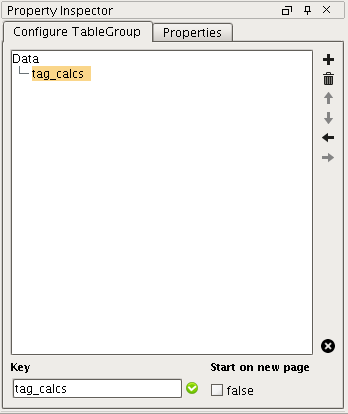Table Groups
Table groups allow you to specify child tables for each object in the master list (using a list key found in each of those objects). It also allows you to specify additional "peer" tables that pick-up exactly where the first table ends (note: multiple tables can also be configured as multiple- page templates, providing a page break between tables).
Table groups and Nested Data Sources in Ignition 7.8 are particularly well suited for each other. We've made it easier than ever before to create things like Summary Tables for categories of items, or drill-down charts.
Usage
-
To turn a table into a table group, simply select the table and click the
 button in the Table Configuration tab of the selected Table. The table is actually a child of a "Table Group" element, which has its own configuration panel in the Property Inspector.
button in the Table Configuration tab of the selected Table. The table is actually a child of a "Table Group" element, which has its own configuration panel in the Property Inspector.

To add a Child or Peer table, click the  button. This will add a whole new table for this "child" list key. You can use the arrow buttons to change the hierarchy of the tables in the group, or remove them with the trash icon. To ungroup, select the
button. This will add a whole new table for this "child" list key. You can use the arrow buttons to change the hierarchy of the tables in the group, or remove them with the trash icon. To ungroup, select the  button.
button.
You can edit each of the different tables in the table hierarchy by clicking their node in the table tree, and then clicking the body component on the page to activate its configuration. Double-click a node to get its table inspector (or double click on the table template in the open document).
You can get back to the table group inspector by clicking on the "Table Group" button at the bottom left corner of the table template, or by selecting the table group node in the Project Browser.
Parent Reference
To reference the parent row object from a child table, you can simply use the key prefix "Parent". So if a row in a movie role child table wanted to display the movie title, it could use the key "@Parent. getTitle@".
Peer Tables
Peer tables are inserted one after another in the parent table. One table could potentially show details for each piece of equipment, with the peer table showing something completely unrelated starting at the end of the table before it.
Child Tables
Child tables are inserted in between each row of the parent table. One table could potentially show details for each piece of equipment, with the child table could show all downtime occurrences for the row on the parent table.